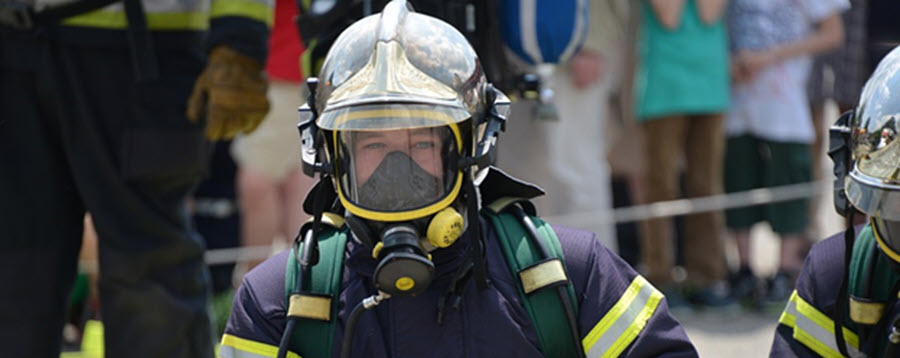
How Can a Good Respiratory Protection Program Save Lives?

In any workplace environment, employee safety is always job one. When most people think about workplace safety, they think hard hats, safety goggles and steel-toed boots. To be sure, safety equipment is an important part of a work safety plan. However, when employees are working with harmful chemicals or contaminants, everyday safety becomes a matter of life and death.
Exposure to airborne toxins can result in immediately constricted breathing to the point of asphyxiation; damage to the membranes in the mouth, throat and lungs or – in the long term – cancer, lung impairment or death. Given these risks, employers are required by law to protect their workers.
The two types of respirators you should know about
According to the Occupational Health and Safety Administration (OSHA), five million Americans are required to use respirators in their workplaces to protect from a range of gases, fumes and airborne particles. There are essentially two types of respirators: those that purify air by filtering out foreign objects, and those that supply clean oxygen from an external source.
The Grainger Corporation lists three types of air-purifying variety of respirators:
- Particulate, which captures particles in the air, including dust, fumes, and mists.
- Gas and vapor, which are generally used only when there are toxic chemicals in the air.
- Combination, which, as the name suggests, filter both gases and particulates.
Atmosphere-supplying respirators are typically used in the most dangerous environments, such as by firefighters inside a burning building. They are also used in underwater SCUBA gear and as emergency respirators on airliners. Many people are not aware that the word SCUBA is actually an acronym that stands for Self-Contained Underwater Breathing Apparatus.
Federal regulations mandate that any workplace requiring its employees to wear respirators must operate under a “Respiratory Protection Plan.” The goal of such a plan is to ensure that workers are not exposed to dangerous toxins.
OSHA requires a protection plan to include the following elements:
- Written procedures
- An evaluation of the program
- The selection of appropriate respirators
- Employee training
- Proper fitting
- Cleaning, maintenance, and storage
- Medical evaluation of employees
- Workspace evaluation
- Air quality
Which respirator is right for my workplace?
All respirators for employee use in the United States must be approved by the National Institute for Occupational Safety and Health (NIOSH). They should be chosen according to the nature of protection they are required to provide. And they should not hamper the employee’s ability to see or to work efficiently.
How do I make sure my respirator fits properly?
How well equipment fits will depend on the type of respirator and the person who must wear it. Because no two faces are alike, no respirator is going to fit everyone. That’s why it is the employer’s responsibility to make sure there is a selection of respirators for employees. At the same time, employees may learn that their beards, nose piercings or eyeglasses can affect fit, and your employer may ask that these things be removed.
What kind of care do respirators require?
Because respirators are often used in very dangerous environments and their failure could result in serious injury or illness, they must be well maintained. All respiratory equipment should be inspected regularly, including tubes, hoses, straps, cartridges and filters. While parts or entire units may be replaced by workers or supervisors, any repairs to damaged equipment should only be undertaken by professionals. Chemical cartridges and gas mask canisters should be replaced as needed according to the manufacturer’s instructions. Equipment that it is to be used by more than one person should be washed in a detergent solution and immersed in a sterilizing solution after every use.
Is my employer taking the right precautions?
Once a company puts a respiratory protection plan in place, OSHA offers the following set of questions for employers so that employees in charge of compliance can determine whether or not they are taking all necessary steps.
- Does a list of the hazardous chemicals exist in each work area or at a central location?
- Are methods outlined to inform employees of the hazards of non-routine tasks?
- Are employees informed of hazards associated with chemicals contained in unlabeled pipes in their work areas?
- On multi-employer worksites, has the employer provided other employers with information about labeling systems and precautionary measures?
- Is the written program available to employees and their designated representatives?
Under federal law, all workers have the right to safe working conditions, the right to adequate training and the right to file a complaint when necessary without fear of retaliation from their employees. Many Americans work in hazardous environments to provide goods and services, and we all owe it to them to ensure they are safe on the job.
Additional Resources:
- Review OSHA respiratory protection training videos.
- NIOSH Respirator Trusted-Source Information.
- NIOSH guide to industrial respiratory protection.
- Browse Respirator PPE safety signs and labels at ComplianceSigns.com.
Author Bio: Jordan McDowell is a writer and content strategist. He specializes in technically oriented B2B and B2C content for a number of digital companies, including Moldex.

